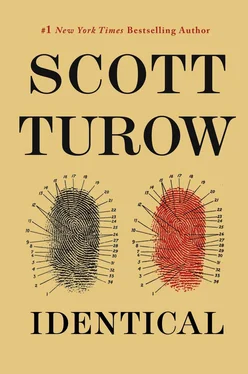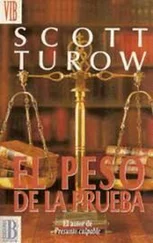Scott Turow - Identical
Здесь есть возможность читать онлайн «Scott Turow - Identical» весь текст электронной книги совершенно бесплатно (целиком полную версию без сокращений). В некоторых случаях можно слушать аудио, скачать через торрент в формате fb2 и присутствует краткое содержание. Жанр: thriller_legal, на английском языке. Описание произведения, (предисловие) а так же отзывы посетителей доступны на портале библиотеки ЛибКат.
- Название:Identical
- Автор:
- Жанр:
- Год:неизвестен
- ISBN:нет данных
- Рейтинг книги:5 / 5. Голосов: 1
-
Избранное:Добавить в избранное
- Отзывы:
-
Ваша оценка:
- 100
- 1
- 2
- 3
- 4
- 5
Identical: краткое содержание, описание и аннотация
Предлагаем к чтению аннотацию, описание, краткое содержание или предисловие (зависит от того, что написал сам автор книги «Identical»). Если вы не нашли необходимую информацию о книге — напишите в комментариях, мы постараемся отыскать её.
Identical — читать онлайн бесплатно полную книгу (весь текст) целиком
Ниже представлен текст книги, разбитый по страницам. Система сохранения места последней прочитанной страницы, позволяет с удобством читать онлайн бесплатно книгу «Identical», без необходимости каждый раз заново искать на чём Вы остановились. Поставьте закладку, и сможете в любой момент перейти на страницу, на которой закончили чтение.
Интервал:
Закладка:
Yavem was a famous guy, whose work concentrated on comparisons of the genomes of family members, research that had led him to establish the genetic basis of a number of diseases. He was mentioned often as a potential candidate for the Nobel Prize in Medicine. Earlier in his career, he had testified in several celebrated criminal trials. These days he referred most DNA identifications to a commercial concern he’d founded and sold a decade ago, instead applying the bulk of his time to research. The forensic cases he took on personally were few, and it was something of an honor that he had agreed to meet Evon, although Hal’s name had undoubtedly carried considerable weight. The Kronons had made two seven-figure gifts to the U, Hal’s alma mater, over the years.
“We’ve known for some time that the environment outside the womb causes some variation in gene expression, called methylation. That is why some identical twins are not completely identical in appearance, as they age. But methylation does not represent any basic genetic difference.”
Evon repeated what Yavem was saying to herself, in her own terms. Methylation explained why Cass appeared just a bit taller and thicker than Paul, when they were side-by-side at the pardon and parole hearing. But that was a difference only in the way the same genes had responded to the world.
“But,” said Yavem, “there are other minute differences in twins’ genomes that are more pertinent to the question you asked. Those are what we call CNVs, for copy-number variations. These appear as segments of DNA that are missing, occur in multiple copies, or have flipped orientation in the genome.
“A human gene consists of hundreds or thousands of combinations of the chemical building blocks, adenine-A for short-cytosine, C, guanine, G, and thymine, T. One segment of the hemoglobin gene, to pick an example in the blood, is CTGAGG. A copy-number variation is like a typo. So CCTG A GG could be switched to CCTG T GG, with thymine substituted for adenine in the genetic sequence. CNVs probably explain why only one twin gets what we think of as a genetically influenced illness. The example I just gave you, with the A switched to a T in the hemoglobin gene, leads to sickle-cell disease.
“Most CNVs are probably benign, and some may prove positively beneficial. They occur in all individuals, not just in identical twins, probably as part of nature’s great ongoing experiment. My own research suggests that about two-thirds of CNVs occur after conception, as part of fetal cell division.”
“So that’s what might be different between Cass and Paul?” she asked. “These CVNs?”
“CNVs,” said Yavem, smiling patiently. The DNA lab visible beside Yavem’s desk through a wide window was far less dramatic-looking than Evon might have expected, not all that different in appearance from where she’d taken high school chemistry, the same collection of beakers and bottles, microscopes and computers and black counters. There were rows of test tubes in blue plastic racks, capped with white stoppers. It was a small space, undoubtedly so the risks of contamination could be controlled, and the three gowned workers within were pretty much elbow to elbow. One man in a surgical mask kept removing his gloves so he could type on his laptop, before turning back to his microscope. A woman was looking at a slide with a piece of red equipment that looked for all the world like a fire alarm.
“Now the theory meets practice. My colleagues in Alabama were able to isolate identifiable CNVs only in roughly 10 percent of twins. So given where we are today, nine times out of ten, you are not going to be able to differentiate identical twins genetically. And even if you found a CNV, it does not occur in all cells of that type. With blood cells, only 70 to 80 percent would contain that CNV, so you would need to confirm your results with a number of specimens.”
“I got it,” she said. There was only a 10 percent chance of success, without considering other problems. “But it is possible? You might get valid results?”
“In theory, of course. But you must understand, even if we found one or more CNVs between your twins, and even if that same CNV occurred in blood at the crime scene, that would not necessarily mean that twin was the perpetrator.”
“What?”
Yavem maintained his mirthful air and smiled again.
“Imagine the CNV we detected was the one I mentioned in the hemoglobin gene. Unfortunately, many people have sickle-cell disease. We would know that only one twin could have contributed the blood at the scene, but not that the blood came from that twin. To make that conclusion, you will still need to do more standard DNA testing, which invites a host of new problems. How much, Ms. Miller, do you understand about DNA comparisons?”
“I started out in the FBI and used to know some,” Evon said. “But it’s a little like high school math. Every time my nieces or nephews show me their homework, it seems to have nothing to do with what I saw from the older ones a couple of years before.”
Yavem loved the analogy. He laughed for some time. It was easy for Evon to see why he was in such high demand as a witness. He was charming, with no trace of arrogance. And no matter who hired him, he would get on the stand without an agenda. Everything about the man said he was above pandering.
“All right,” he said. “I’ll go back to the beginning. Roughly 99 percent of the genome is the same in each human. But the genes of every person contain certain regions of DNA sequences that differ from individual to individual, basically in terms of how often they repeat. By developing a technique to examine these DNA repeat sequences-by finding an enzyme that could break them apart, actually-Sir Alec Jeffreys in England created human identity tests in 1984. Those tests look to a small number of loci in the genome where repeat differences have been studied and cataloged so we know how often they occur. With matches at some or all of those loci, we can then say statistically that only one person in a million, or even a billion, has the same DNA repetitions.”
Trying to take this in, Evon looked up to the acoustical tiles on the ceiling. This was basically what she’d first learned at an in-service at Quantico, when she went back for further training in the early nineties.
“But that’s not hard these days, is it?”
Yavem smiled. “That depends. Do you know how these specimens you want to test have been stored?”
“Not yet.” The truth, which she wasn’t ready to confess, was she didn’t even know if the evidence still existed. Tim had dug up the inventories recorded by the state and local evidence techs, so she knew what had been collected originally. As far as Evon could tell, after making a few phone calls, the state crime lab tended to preserve evidence in murder cases as a matter of protocol. But that was a rule with many exceptions. Exhibits frequently were never retrieved from the court file, or after a case ended. Rather than retransmitting the evidence to the records section, troopers and deputy PAs frequently dumped it in a drawer, where the specimens moldered until they were thrown out. But the prominence of the Kronon case, with a gubernatorial candidate’s daughter as the murder victim, made it more likely things had been done by the book. If so, the blood by the window, which had to be from the murderer, would be of special interest.
“You can be all but certain,” Yavem said, “that evidence gathered in 1982 was not stored in a way designed to preserve DNA. No fault of the techs for not being mindful of a technology that didn’t exist. But DNA breaks down over time, just like any other cellular material. Blood specimens might have been refrigerated. But we can also extract DNA from fingerprints-since they’re really sweat residue-but no one really practices precise temperature control in storing prints. Then there’s the issue of contamination. No one knew that they should be careful about shedding their own DNA-skin cells, for example-into the specimens they were collecting.
Читать дальшеИнтервал:
Закладка:
Похожие книги на «Identical»
Представляем Вашему вниманию похожие книги на «Identical» списком для выбора. Мы отобрали схожую по названию и смыслу литературу в надежде предоставить читателям больше вариантов отыскать новые, интересные, ещё непрочитанные произведения.
Обсуждение, отзывы о книге «Identical» и просто собственные мнения читателей. Оставьте ваши комментарии, напишите, что Вы думаете о произведении, его смысле или главных героях. Укажите что конкретно понравилось, а что нет, и почему Вы так считаете.












